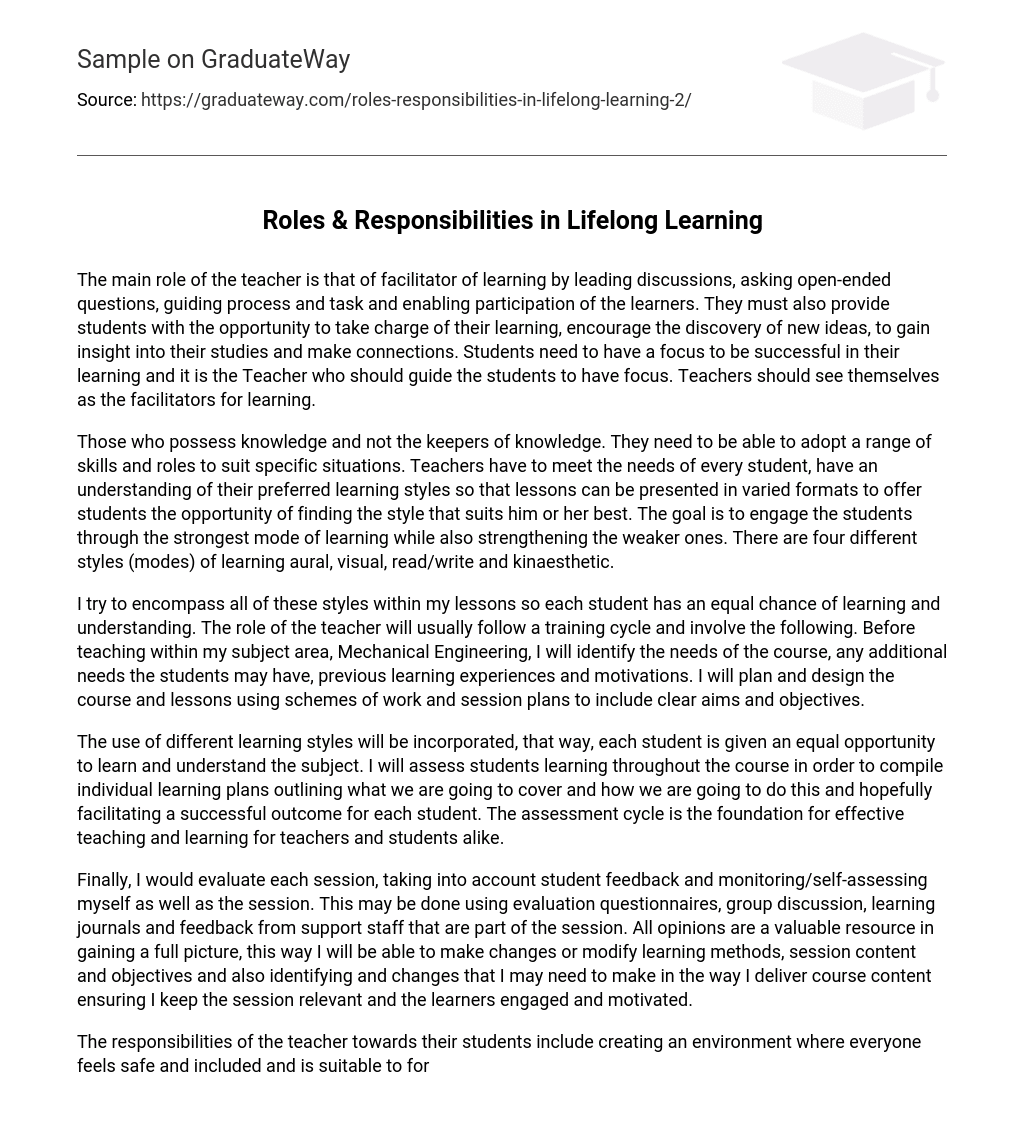The primary responsibility of teachers is to facilitate learning. This involves leading discussions, posing open-ended questions, guiding processes and tasks, and promoting learner participation. Additionally, teachers should offer students opportunities to assume control over their own learning, foster the exploration of new ideas, gain perspective in their studies, and establish connections. To guarantee student achievement in learning, it is crucial for teachers to guide them towards maintaining a focus. Therefore, teachers should perceive themselves as facilitators of learning.
Teachers must have the knowledge and skills to fulfill both educational and knowledge-holding roles. They should be capable of adjusting their roles and abilities to fit different circumstances. To cater to the needs of every student, teachers need to comprehend their preferred learning styles and deliver lessons in diverse formats. This enables students to discover their most effective learning style. The goal is to engage students through their dominant mode of learning while also enhancing weaker areas. The four primary learning styles include auditory, visual, reading/writing, and kinesthetic.
In my lessons, I aim to incorporate all these styles to ensure that every student has an equal opportunity to learn and comprehend. Generally, the role of the teacher follows a training cycle and includes the following steps. Prior to teaching in my field of expertise, Mechanical Engineering, I will assess the requirements of the course, any individual needs of the students, their past learning experiences, and motivations. I will then create a well-structured course and lessons by utilizing schemes of work and session plans that outline clear aims and objectives.
Each student will be given an equal opportunity to learn and understand the subject by incorporating different learning styles. I will assess students’ learning throughout the course to create individual learning plans that outline the topics and methods we will cover, ultimately facilitating a successful outcome for each student. The assessment cycle is crucial for effective teaching and learning for both teachers and students.
In conclusion, I would assess each session by considering student feedback and monitoring/self-assessing myself and the session. This can be achieved through the use of evaluation questionnaires, group discussions, learning journals, and feedback from support staff involved in the session. All viewpoints are important for obtaining a comprehensive understanding, allowing me to make adjustments or revisions to learning techniques, session content, and objectives. Additionally, I can identify any necessary modifications to my course delivery to ensure the session remains relevant and keeps learners engaged and motivated.
The teacher’s duties towards their students encompass establishing a safe and inclusive learning environment. This involves not only the physical space and resources but also the attitude of both staff and fellow students, as well as the level of support provided to students. Additionally, teachers must be ready to handle disruptive or problematic behavior and understand that situations can quickly change.
I strive to maintain a positive, firm, fair, and friendly approach. A narrow-minded harsh attitude will only negatively impact the learner. Additionally, I incorporate structure and order in my sessions and aim to be an approachable and professional role model in teaching and engineering. It is crucial for a teacher to stay updated on changing engineering legislation and working practices to provide students with current and relevant information during lessons.
A teacher should possess effective communication skills and the ability to actively listen to students. Active learning is more beneficial compared to passive learning. Teachers are required to acknowledge and respect the individuality and diversity of their students, while recognizing their specific needs and goals in order to promote learner autonomy. It is important that any health issues are promptly addressed and managed in order to ensure a safe learning environment. In this workshop, there will be a certified college first aider available for any health concerns that may arise. Additionally, risk assessments need to be completed, and students should be informed about college accident and fire procedures. Keeping updated records is crucial for tracking progress, assessment processes, and monitoring attendance. Lastly, teachers must maintain professional boundaries and understand the limitations of their role.
Always maintaining confidentiality and adhering to organizational codes of conduct is crucial. Exercise caution regarding physical contact to prevent misunderstandings. It is advisable to regularly reflect on and evaluate our behavior, learning from past experiences and being prepared for challenging and unforeseen situations.
The topic of the text is “Books”.
Bloom BS (ed) (1956) Taxonomy of Educational Objectives: The Classification of Educational Goals, New York: McKay.
Daines JW et al (2006) Adult Learning, Adult Teaching, 4th edition, Cardiff: Welsh Academic Press.
Gravells A, Simpson (2008), 3rd edition, Preparing to Teach in the Lifelong Sector, Exeter: Learning Matters.
Websites
There are multiple websites that offer links to resources for different learning styles. Some examples of these websites include:
Cognitive Learning Styles – cityandguilds.com





